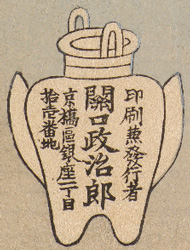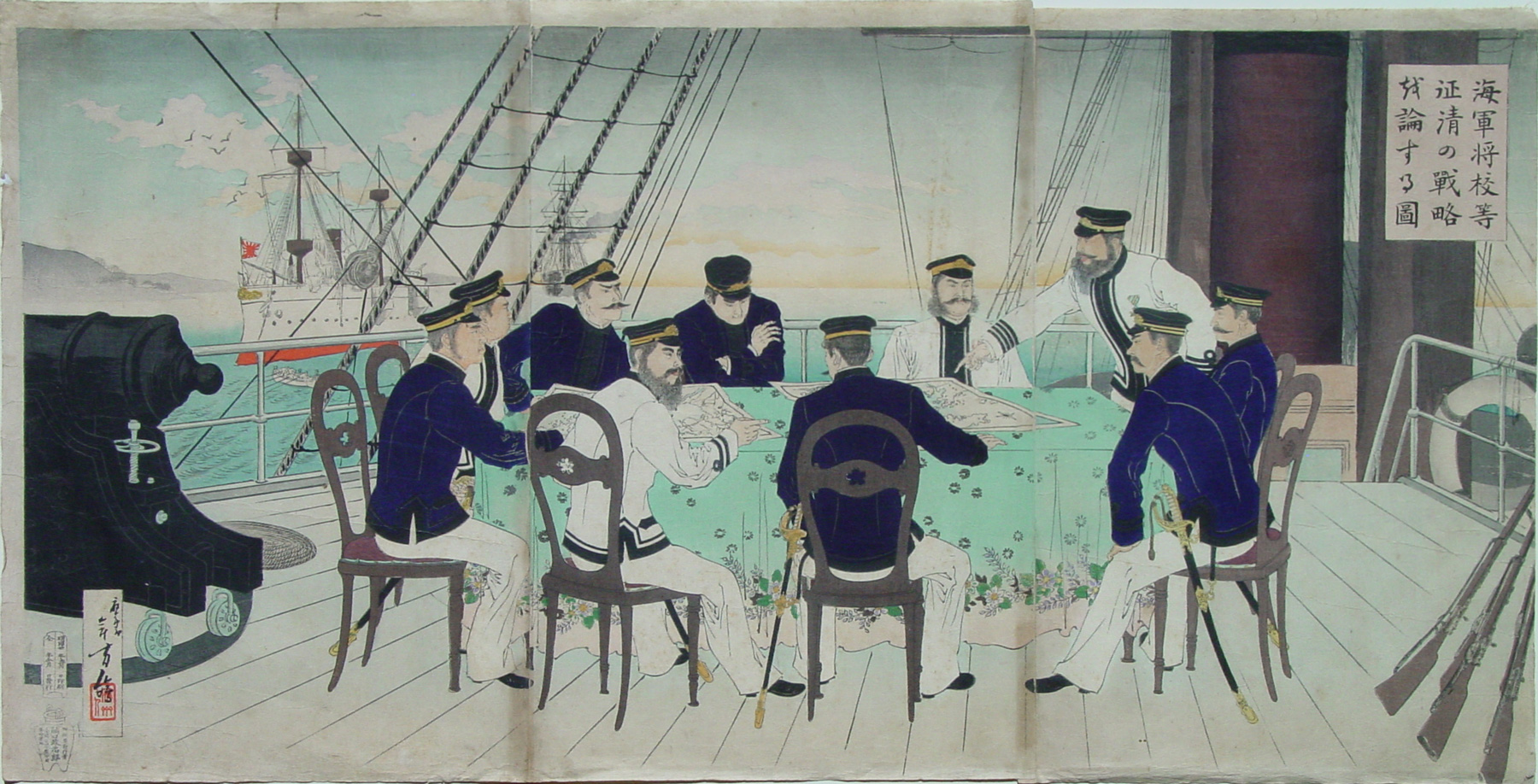About This Print
Source: In Battle's Light: Woodblock Prints of Japan's Early Modern Wars, Elizabeth de Sabato Swinton, Worcester Art Museum, 1991. p. 75."The Japanese fleet attacked Port Arthur and Weihaiwei on August 10 and then patrolled the coast while they transported troops to the area. On September 13, 1894, Japanese naval officers met on shipboard to plan the strategy for the battle for control of the Yellow Sea.
Toshikata's skills as an illustrator are evident here. The interaction of the figures through gaze, body position, and gesture informs the viewer that real discussion is taking place. The close-up view of the protagonists gathered around the table, while the other Japanese ships wait in the background, dramatizes this portentous meeting. The artist's successful representation of space and perspective is the result of his training in the Maruyama-Shijo style and not the new Meiji Western style painting (yoga)."
Source: The World of the Meiji Print: Impressions of a New Civilization, Julia Meech-Pekarik, Weatherhill, 1986, p. 203, 206.
"In a triptych dated September 1894, Mizuno Toshikata (1866-1908) portrayed senior naval officers debating strategy on the eve of Japan's decisive victory for control of the Yellow Sea. The encounter, which took place on September 17, is said to have been the first naval battle in history between steam-powered fleets. The men are aboard one of Japan's twelve warships, all built in Britain. One advantage the Japanese had was rapid-firing artillery as exemplified by the deck gun visible in the left panel of the print. It is a scene of calm before the angry storm; the balanced, symmetrical composition and subdued coloring contribute to the dignified, serious mood of the occasion. Dressed to kill, this snappy group could easily be mistaken for Westerners."
Battle of the Yellow Sea
Source: Japan at the Dawn of the Modern Age – WoodblockPrints from the Meiji Era, Louise E. Virgin, Donald Keene, et. al.,MFA Publications, 2001, p.72."The Battle of the Yellow Sea was...important to the Japanese because the West greatly respected naval might. As the first naval battle in history between steam-powered boats, it was widely covered in international magazines and newspapers - some paid by the Japanese government to favorably cover the war. Many print artists were also inspired (or commissioned) to produce sensational, panoramic scenes of the struggle between the Japanese Combined Fleet of twelve warships led by the Matsushima, and the Chinese Peiyang, or Northern Fleet, led by the Tingyuen."
Print Details
| IHL Catalog | #444 |
| Title or Description | Naval Officers Discussing the Battle Strategy for the Invasion of China Kaigun shōkō tō seishin no senryaku giron suru no zu [Kaigun shōkōra seishin no senryaku o ronsuru zu] 海軍将校等征清の戦略議論する図 |
| Artist | Mizuno Toshikata (1866-1908) |
| Signature |  |
| Seal | Ōsai shujin |
| Publication Date | September, 1894 (Meiji 27) |
| Publisher |  |
| Impression | excellent |
| Colors | good |
| Condition | fair - three panel joined; full-size, not trimmed; wrinkling and soiling throughout; margin damage and several holes repaired from back. |
| Genre | ukiyo-e - senso-e (Sino-Japanese War) |
| Miscellaneous | |
| Format | vertical oban triptych |
| H x W Paper | 14 1/2 x 28 3/4 in. (36.8 x 73.0 cm) |
| Literature | The Sino-JapaneseWar, Nathan Chaikin, self-published, 1983, p. 152, pl. 42; Japan at the Dawn of the Modern Age – WoodblockPrints from the Meiji Era, Louise E. Virgin, Donald Keene, et. al.,MFA Publications, 2001, p.76, pl. 30; Japan Awakens: Woodblock Prints of the Meiji Period (1868-1912), Barry Till, Pomegranate Communications, Inc., 2008, p. 101; In Battle's Light: Woodblock Prints of Japan's Early Modern Wars, Elizabeth de Sabato Swinton, Worcester Art Museum, 1991. p. 75, pl. 41; The World of the Meiji Print: Impressions of a New Civilization, Julia Meech-Pekarik, Weatherhill, 1986, pl. 32; Conflicts of Interest: Art and War in Modern Japan, Philip K. Hu, et. al., Saint Louis Museum of Art, 2016, p. 117 pl. 27. |
| Collections This Print | Smithsonian National Museum of Asian Art S2003.8.1481; Museum of Fine Arts, Boston 2000.380.9a-c; Art Gallery of Greater Victoria 1991.042.005; The Metropolitan Museum of Art; National Diet Library 8-5-1-2 01-007, 008, 009; JP3260; The National Gallery, Prague; British Library shelfmark: 16126.d.1(47) and 16126.d.2(101); Saint Louis Museum of Art 7842010a-c |
4/15/2020


